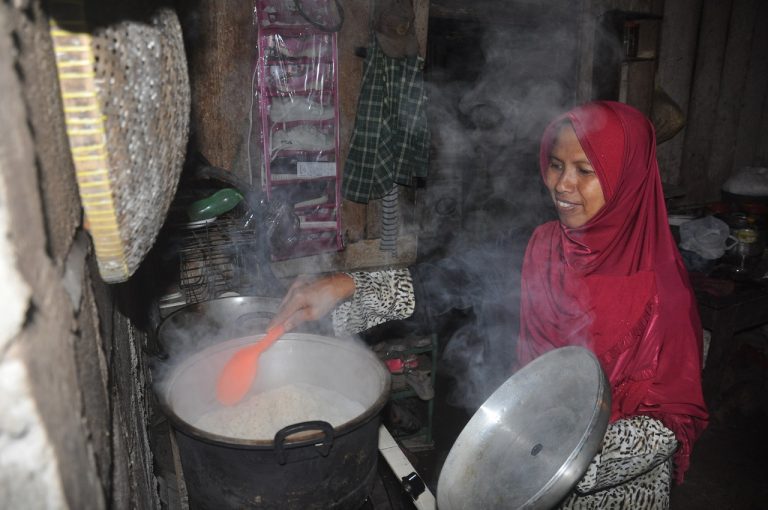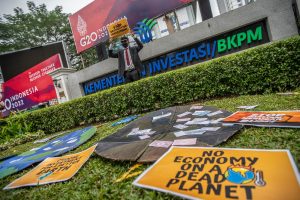Healthy food and local identity
by: Hartatik
Wonosobo – For many young people, lunch means rice bowls, smashed chicken, or Korean dishes at trendy cafés. But for some millennials in Wonosobo, Central Java, true pride comes from serving a plate of leye—a traditional cassava-based staple that has been cherished and passed down through generations.
Even so, the challenges are far from small — from the lingering stigma of leye as “poor people’s food” to its time-consuming production process, which has often pushed it to the margins. Yet, the younger generation in this mountainous region of Central Java is stepping up to the forefront to keep this culinary heritage alive.
Fitriyah (45), a resident of Pasunten Hamlet, Lipursari Village, Leksono Subdistrict, Wonosobo Regency, has been familiar with the aroma of steamed cassava filling her wooden kitchen since she was little. Every day, Fitriyah cooks one kilogram of leye to feed six people: herself, her husband, her two children, and her parents. Fitriyah’s family has been consuming leye for decades. Even her youngest child, Zafa (13), can be seen enjoying a plate of leye with fried noodles.
Now, her teenage daughter is learning how to make gaplek, the basic ingredient for leye. Leye is shaped like small grains of rice, is clear brown in colour, odourless, and can be stored for a long time.
“My children are not ashamed to eat leye. Sometimes they even proudly post it on social media, saying it’s healthy food,” said Fitriyah with a smile.
This simple act reflects how age-old traditions are being preserved through modern media. Once passed down only by word of mouth, leye recipes are now being documented by Wonosobo’s millennials through digital content—ranging from video tutorials and culinary vlogs to Instagram pages celebrating local cuisine.
Stigma and a Long Process
It cannot be denied that leye is still often regarded as an inferior food. Yasid Taufik, Head of the Centre for Consumption Diversity and Food Safety at the Ministry of Agriculture, acknowledges that this stigma remains prevalent.
“Sadly, people who consume cassava are considered poor. In fact, it has tremendous potential as a substitute for rice,” he said in a webinar titled ‘Eating Cassava Makes You Healthy.’
This stigma is compounded by the lengthy process of making leye. The cassava must first be peeled and soaked for two nights to remove its natural cyanide toxins, then dried under the sun, ground, and finally steamed. The entire process can take between five and seven days.
“Making leye requires patience. It’s not instant. That’s why many people prefer rice,” said Qoniah (59), a resident of Pasunten who has been processing cassava for a long time.
In Wonosobo, many communities still preserve the traditional methods of making nasi leye. One such example can be found in Pucung Rubuh Hamlet, Leksono Village, where residents continue to use a mortar and pestle to pound cassava into fine powder. Alongside these, traditional pottery tools like kepang—woven bamboo trays—are used to dry and sift the nasi leye, maintaining the authenticity of this age-old craft.
Several villages in Wonosobo—such as those in the highland subdistricts of Leksono, Kaliwiro, and Wadaslintang—are not suitable for rice cultivation. Aware of their daily food needs, local communities have long turned to cassava as an alternative staple, commonly processed into leye.
In Lipursari Village, leye has long served as a substitute for rice across generations. Cassava, the main ingredient of leye, is abundant in this village, which sits about 500 meters above sea level. With each planting season, Fitriyah’s husband, Mukmin (55), can harvest several tons of cassava.
For many residents, leye is not only a traditional dish but also a practical alternative that helps reduce household expenses. Rice can only be harvested once a year here, as irrigation for the fields depends entirely on rainfall.
Millennials are trying new paths
Despite these challenges, the younger generation is taking a fresh approach. Some rural youth communities are reimagining cassava by serving it in modern buffet-style dishes or pairing it with contemporary side dishes. Others are promoting it as a healthy alternative, emphasising that cassava has a lower glycemic index than rice.
Atik Nurzuati, a resident of Wonosobo who lives in Yogyakarta, admits that when she returns to her hometown, she often feels nostalgic and craves traditional dishes such as nasi leye. She has a favourite food stall that sells nasi leye with additional side dishes such as urap vegetables, salted fish, tempe ndeso, tempe bacem, and buntil.
“A serving of nasi leye with urap vegetables and rese (salted fish) costs only 3,000 rupiahs. Add tempe bacem for 2,000 rupiahs and buntil daun lumbu for 3,000 rupiahs. So, for less than 10,000 rupiahs (USD 0.60), you can eat your fill and stay healthy,” said Atik while uploading a video of leye rice on Instagram.
Dicky Senda, a local food activist from the Lakoat Kujawas Community, believes that the creative efforts of millennials are important in restoring pride in local food.
“Instead of conforming to imported foods, it is better for us to explore local knowledge. Millennials can be agents of change because they understand the market and are familiar with digital culture,” he said.
For farmers like Mukmin (55), cassava is more than just a source of food—it is also an economic lifeline. Unfortunately, the selling price of fresh cassava to middlemen is only around IDR 700 (USD 0.042) per kilogram, far below the value of processed cassava products, which can reach up to IDR 20,000 (USD 1.20) per kilogram. This stark gap has inspired the younger generation to look beyond cultural preservation and explore cassava as a promising business opportunity.
“Nowadays, many people are looking for leye for health reasons. So it’s actually more expensive than rice. Young people can play a role by processing and marketing it,” said Tarwiyah (53), a leye producer who remains actively supplying the market.
According to data from BPS–Statistics Indonesia in 2018, cassava productivity in Wonosobo reached 29,051 kilograms per hectare, making the district one of the key cassava-producing areas in Central Java. Although more recent productivity figures are not yet available, BPS data show that in 2024, Wonosobo’s cassava harvest area reached 2,653 hectares—ranking fourth largest in the province.
Without regeneration, the tradition of leye risks fading into obscurity. Today, millennials in Wonosobo face a choice: let leye become a relic of the past or transform it into a symbol of healthy living and local identity. Fitriyah is confident her children will choose the latter.
“If we don’t preserve it, who else will? Leye is not just food—it’s a part of Wonosobo’s soul,” she said.
Continue reading:
Part 2: https://tanahair.net/from-villages-to-social-media-how-millennials-preserve-nasi-leye-1-3/
Part 3: https://tanahair.net/from-villages-to-social-media-how-millennials-preserve-nasi-leye-2-3/
Banner photo: Fitriyah (45), a resident of Pasunten Hamlet, Lipursari Village, Leksono Subdistrict, Wonosobo Regency, Central Java, steams leye before serving it with side dishes and vegetables. (Hartatik)
This coverage is part of the “Journalist Fellowship and Mentorship Program for Sustainable Food System 2025” scholarship supported by the Sustainable Food System Coalition (KSPL) in collaboration with AJI Jakarta.















